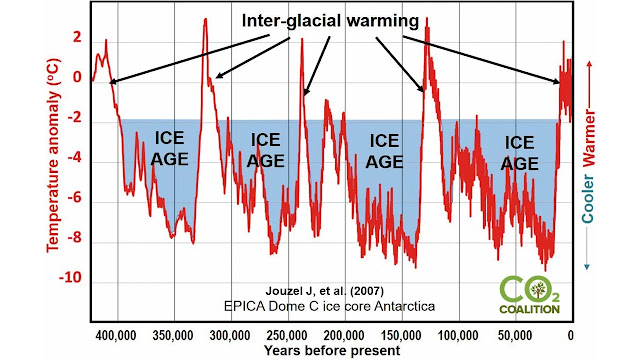Responding to the CO2 Coalition's "Fact #14" on Glacial Cycles
CO2 Coalition's "Fact #14" appears to be pretty trivial, and as best I can tell, it exists here to scare people into being afraid of a coming ice age. Over the last million years (since the Mid-Pleistocene Transition), glacial cycles have been about 100K years long, synced with orbital cycles. For most of each glacial cycle, the Earth is in a glacial period, with continental ice sheets extending into mid-latitudes, but for about 10K-15K years, the Earth experiences an "interglacial" period, when global temperatures increase and continental ice sheets retreat. Our current interglacial, the Holocene, has lasted about 11,700 years, and the major ice sheets are restricted to Greenland and Antarctica. None of this is particularly controversial or relevant to whether AGW is causing harm to human civilization.
Now technically, the above graph shows the last 420K years of the current ice age. There are not multiple ice ages in the Quaternary. Even the interglacial periods are part of the Quaternary ice age. The graph should be labeled with glacial vs interglacial periods. But that's neither here nor there. |
| A Geologic Perspective on CO2, from Rae et al 2021 |
[1] Alley RB, Clark PU, Huybrechts P, Joughin I. Ice-sheet and sea-level changes. Science. 2005 Oct 21;310(5747):456-60. doi: 10.1126/science.1114613. PMID: 16239468.
https://pubmed.ncbi.nlm.nih.gov/16239468/
[2] M. Robinson, “Pliocene Role in Assessing Future Climate Impacts” Eos 89, No. 49 (2008). https://agupubs.onlinelibrary.wiley.com/doi/epdf/10.1029/2008EO490001
[3] IPCC AR4, 6.3.2 “What Does the Record of the Mid-Pliocene Show?” https://www.ipcc.ch/site/assets/uploads/2018/02/ar4-wg1-chapter6-1.pdf
[4] Julie Brigham-Grette, “Pliocene Warmth, Polar Amplification, and Stepped Pleistocene Cooling Recorded in NE Arctic Russia” Science 340 (June 21, 2013).
http://science.sciencemag.org/content/340/6139/1421
[5] Stephanie Paige Ogburn etal. “Ice-Free Arctic in Pliocene, Last Time CO2 Levels above 400 PPM: Sediment cores from an undisturbed Siberian lake reveal a warmer, wetter Arctic.” SA
https://www.scientificamerican.com/article/ice-free-arctic-in-pliocene-last-time-co2-levels-above-400ppm/
[6] Rhian L.Rees-Owen. “The last forests on Antarctica: Reconstructing flora and temperature from the Neogene Sirius Group, Transantarctic Mountains” Organic Geochemistry Volume 118, April 2018, Pages 4-14
https://www.sciencedirect.com/science/article/pii/S014663801730219X
[7] Damian Carrington, “Last time CO2 levels were this high, there were trees at the South Pole.” The Guardian
https://www.theguardian.com/science/2019/apr/03/south-pole-tree-fossils-indicate-impact-of-climate-change




Comments
Post a Comment